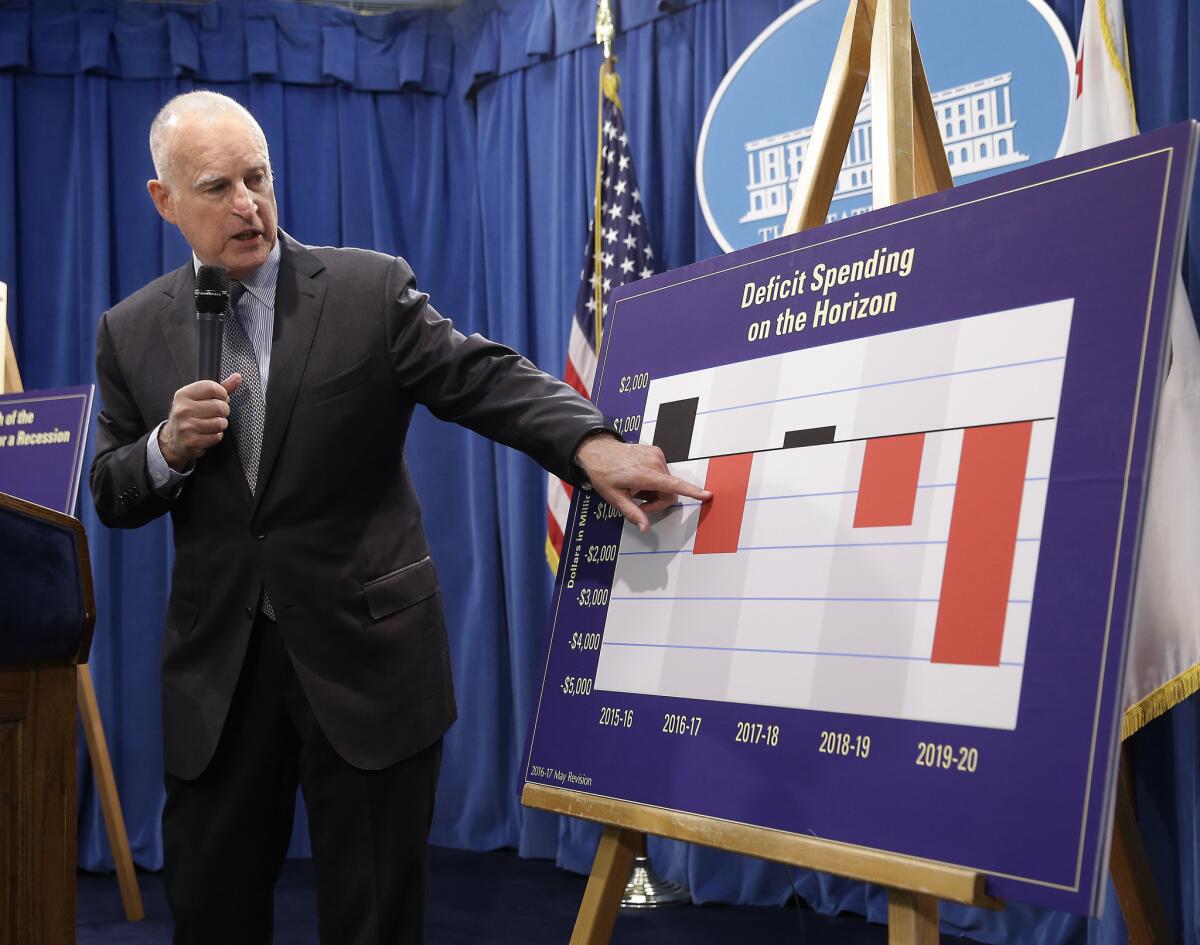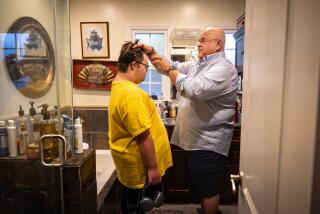An in-home care program for California’s elderly and disabled is constantly at the heart of budget battles. Here’s why

Reporting from Sacramento — California’s program to provide in-home care for its low-income elderly and disabled residents finds itself once again at the heart of a state budget standoff.
It is familiar territory for the workers, advocates and administrators of the In-Home Supportive Services program. The current flare-up — between the state and county governments over how to divvy up IHSS costs — is the latest example of how California’s signature program, meant to keep people in their communities and out of nursing homes, has continually been the source of budget friction in recent years.
For the record:
4:07 p.m. Nov. 5, 2024An earlier version of this article gave the name of the union representing in-home caregivers as Service Employees International Union — United Long Term Care Workers’ Union. It is SEIU 2015.
The tussling comes at a crucial time for the program, which now cares for more than half a million people — and, more broadly, for California, as the state braces for a swell of demand for care from an aging population. By 2036, residents age 65 or older are expected to make up nearly a quarter of the population, according to state projections, up from 14% last year.
“It gets exhausting, to tell you the truth,” said Laphonza Butler, president of SEIU 2015, which represents in-home caregivers, of the recurring budget battles. “But at the same time, in my opinion there’s no more important conversation to be having. California’s population is aging and it is aging rapidly.”
Advocates for both the workers and consumers of the program say IHSS benefits consumers by keeping them in their homes — and saves the state money on pricey institutional care.
“Overall, it is an invaluable program and it really has accomplished a lot of the goals it set out to accomplish,” said Claire Ramsey, an attorney with Justice in Aging, an advocacy group.
Born from a disability rights movement
Far more than most states, California has embraced the concept of in-home caregiving, which involves assistance with a wide range of daily living tasks such as bathing, feeding, house cleaning and administering medications. There are between 600,000 and 800,000 providers offering in-home care throughout the country, said Candace Howes, an economics professor at Connecticut College, and more than 500,000 of them are in California.
“California did this in part in response to a civil rights movement among disabled people,” said Howes, who has studied the IHSS program. “It was spawned by Vietnam veterans coming back and wanting to have care in the community, rather than institutions.”
As a part of the state’s Medi-Cal program, IHSS is an entitlement for anyone who meets the income qualification. Recipients cannot have assets greater than $2,000 — or $3,000 per couple — with certain property, such as homes or vehicles, being excluded from that total.
The federal government typically covers 50% of the cost of the program — that share has gone up for some recipients under the Affordable Care Act. The state and counties cover the rest. Counties administer the program by determining eligibility and assessing how many hours of care each recipient will need. But the ultimate authority rests with the consumer, who gets to pick his or her caregiver. About 70% of program recipients employ a family member as their in-home caregiver. Providers must enroll with the county and pass a background check, but there are no additional training or certification requirements.
California’s budget deficit is back, Gov. Jerry Brown says »
Alaina Brooks said in-home care has been a life-changer for her brother, Anthony Cheatham, 59, who was paralyzed by a gunshot wound more than 20 years ago. Cheatham had been living in a nursing home in Texas, but inattentive care led to dry rot in his legs, eventually requiring amputation, Brooks said.
Now, Cheatham is living in Brooks’ Palmdale home and has been hospitalized only once in six years, she said.
Brooks’ brother was assessed the maximum amount of care possible, 283 hours per month, for which Brooks is paid $11 an hour.
“We don’t go into this for the money,” said Brooks, 51, a former real estate agent who is now active in her union. “That’s barking up the wrong tree. It’s because it needs to be done.”
Recent budget battles
Backers of the program found themselves playing defense during the recession, when then-Gov. Arnold Schwarzenegger called for anti-fraud measures to tamp down on costs and sought reductions to provider’s wages and the number of hours recipients would be eligible for.
The cuts continued as Jerry Brown returned to the governor’s office. In 2011, he sought to slash IHSS service hours, which range from one to 283 hours per month, by 20%. That move was ultimately blocked by a court injunction, but milder cuts, initiated in the Schwarzenegger years, were kept in place.
Butler, who also leads SEIU’s statewide council, credited Brown for trying “to engage constructively” — but, she hastened to add, “not always in ways that we have agreed with and not always in ways that demonstrate the level of importance of this program to so many Californians.”
Debbi Thomson, deputy director of the adult programs division of the state Department of Social Services, said the administration recognizes the role IHSS has in keeping residents in their homes and out of nursing facilities.
“We feel like it’s a valuable program, absolutely,” she said.
California’s healthier post-recession finances put an end to the string of cuts, and in 2015, Brown restored the service hours that had been cut by 7% in previous years.
Still, there were other points of friction. At Brown’s insistence, in-home caregivers were cut out of a 2014 measure to give paid sick leave to all workers in the state. Last year, as part of the deal struck by Brown and labor leaders to raise the minimum wage to $15 an hour by 2022, IHSS workers secured paid sick days, which will take effect in 2018.
Once fully phased in, the increased minimum wage is expected to cost the state more than $1.2 billion just for the IHSS program, according to Department of Finance projections. Compounding the costs are federal labor regulations that went into effect in 2016 that require overtime pay for home care workers.
Other changes from Washington could have more dramatic impact. The now-stalled Republican healthcare overhaul included a drastic restructuring of Medicaid financing. Proposals such as block grants, which cap how much money the federal government would provide to states, could mean a more existential threat to IHSS as an entitlement program.
“It’s really hard to predict what is going to happen at the federal level at this point,” Thomson said.
A face-off between states and counties
The latest kerfuffle centers on a program called the Coordinated Care Initiative, a pilot program started in 2012 that tried to better administer benefits for people on both Medi-Cal and Medicare. The program drastically changed the cost-sharing between the state and counties for IHSS.
Under the initiative, the counties, which typically paid for 35% of the program, had their share capped at 2011-2012 levels, plus an annual growth factor. The state picked up the rest of the tab.
But this year, the Brown administration announced the initiative was not saving the state money. The governor wants to continue most of the components of the pilot program meant to help with coordinating care. But he has proposed restoring the old IHSS cost-sharing arrangement, which would shift $600 million back to the counties.
Counties warn such a burden could imperil their finances or other programs they administer.
“IHSS is a federal entitlement. That’s the least likely program to be cut” by the counties, said Matt Cate, executive director of the California State Assn. of Counties. “Instead you’ll see cuts to other health and human services programs, perhaps other law enforcement and other general fund programs.”
Counties — which are aligned with labor and consumer groups in their concerns — and administration officials say they’re working on a solution, although they remain tight-lipped about negotiations.
“We are in ongoing discussions with the administration and we’re encouraged by both the governor’s engagement and [legislative leaders’] engagement,” Cate said.
Meanwhile, IHSS backers are hoping for a broader policy discussion that looks beyond year-to-year budget dust-ups to the program’s long-term viability.
“I wish we could have a conversation that was more about what it is that we need to do to prepare for the future as opposed to what do we need to do to pass a budget for the next six months,” Butler said.
Follow @melmason on Twitter for the latest on California politics.
ALSO
Political Road Map: California has $55 billion in tax breaks, and many are here to stay
Four big ways California would be affected if the GOP health plan passes
More to Read
Get the L.A. Times Politics newsletter
Deeply reported insights into legislation, politics and policy from Sacramento, Washington and beyond. In your inbox three times per week.
You may occasionally receive promotional content from the Los Angeles Times.











